10 Small Chicken Breeds That Are Beginner-Friendly
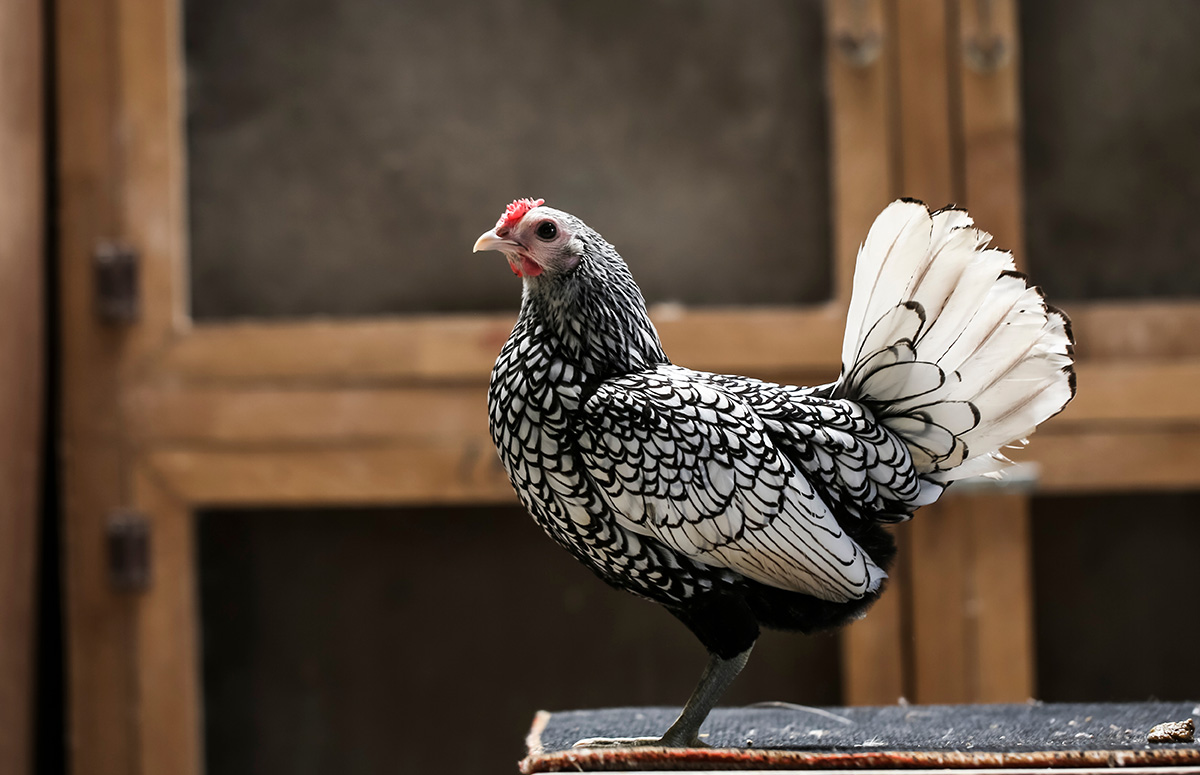
Small chicken breeds can be a great addition to your backyard flock, especially when you don’t have much garden space. Kids also love these miniature birds and keep them as pet chickens.
We made a list of our Top 10 miniature chicken breeds that are:
- Beginner-Friendly
- Decent Egg Layers
- Docile and Sociable
Let’s start by addressing these tiny birds and get you on your way! We are not handling small breeds that are high in care and are best kept only by poultry connoisseurs; we only discuss suitable backyard pets for hobbyists.
If you’re looking for a giant chicken instead of a smaller version, check out our complete ‘Giant Breed Guide‘ or go to our ‘Breed‘ page.
- Silkies
- Dutch Bantam
- Serama
- Belgian D’Uccle
- Cochin (Pekin) Bantam
- Sebright
- Modern Game Bantam
- Appenzeller Bantam
- Belgian Barbu d’Anvers
- Booted Bantam
1. Silkies
| Weight hen | Weight rooster |
| 2 lb (0,9 kg) | 3 lb (1,3 kg) |
Silkies are widely known because of their fluffy appearance and friendly nature. They make excellent pet chickens! Silkies look nothing like ordinary chickens, with their fluffy appearance, five toes, blue earlobes, and black skin.
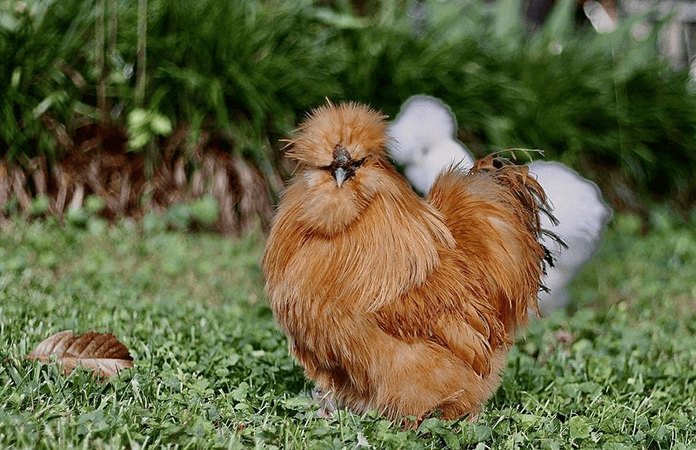
Silkie chickens are small, cuddly, and sweet animals; some even like to keep them inside the house as pets wearing a chicken diaper.
They love the company of humans and want to be cuddled. You can even teach them how to do tricks! But remember that Silkies, even when kept as pet chickens, need their outside space, like any other chicken.
They are ornamental birds bred for their looks. However, Silkies are still decent egg layers, laying up to three eggs per week, that’s around 160 eggs yearly.
There is a ‘but’ to keeping Silkies: they are incredibly broody birds. This makes them excellent mothers, but it can be pretty annoying when you’re not planning to hatch eggs. They do not lay eggs when broody, and some Silkies will forget to eat or drink.
Things to keep in mind before buying a Silkie:
- Not suited for all weather types. Their fluffy plumage does not like wet or cold weather, as it’s not waterproof. The Silkie chicken is not the best choice when living in this climate.
- Are easily bullied or low in the pecking order. Don’t keep Silkies together with dominant breeds such as Rhode Island Red.
- Easy target to predators. They have bad eyesight due to the feathers covering their eyes, which makes them vulnerable to predators. Keep them in an enclosed run to keep them safe.
- Often broody. Which temporarily stops egg production.
2. Dutch Bantam
| Weight hen | Weight rooster |
| 18 oz (500 gr) | 20 oz (550 gr) |
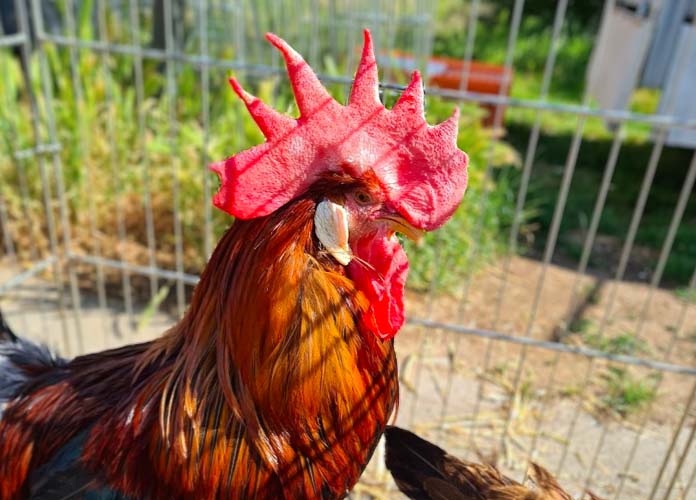
The Dutch Bantam is one of the true Bantam breeds in the world. This means it’s a naturally small chicken with no related bigger poultry breeds which it originated from. They have a single-sized comb with five points and remarkable medium-sized almond-shaped white earlobes.
Although the Dutch Bantam is a small chicken, they’re pretty hardy birds, which makes them beginner-friendly. However, they don’t stand cold temperatures well because of their body size and comb type.
At this moment, Dutch Bantams are mainly kept as show birds, but they are decent egg layers too! Dutch Bantams lay up to 160 cream-colored eggs per year. They’re not especially known to go broody, but it can happen occasionally.
They are friendly birds with energetic personalities. Their size and wings can make them somewhat flighty, so you’ll need to take precautions if you don’t want them to flap over the fence. Dutch Bantams are not really lap chickens like Silkies, but they are sociable and a great asset to your backyard flock.
Things to keep in mind before buying a Dutch Bantam:
- Don’t like cold weather. If you’re living in a harsh environment, many cold-hardier breeds are available.
- Somewhat flighty. They can easily flap or fly over the fence, so make sure to make the fence high enough or cover the run with hardware cloth.
- Easy target for predators. Smaller-sized chickens are more vulnerable to predators than medium-sized chickens. Free-ranging them may not always be a good idea.
3. Serama
| Weight hen | Weight rooster |
| 14 oz (400 gr) | 18 oz (500 gr) |
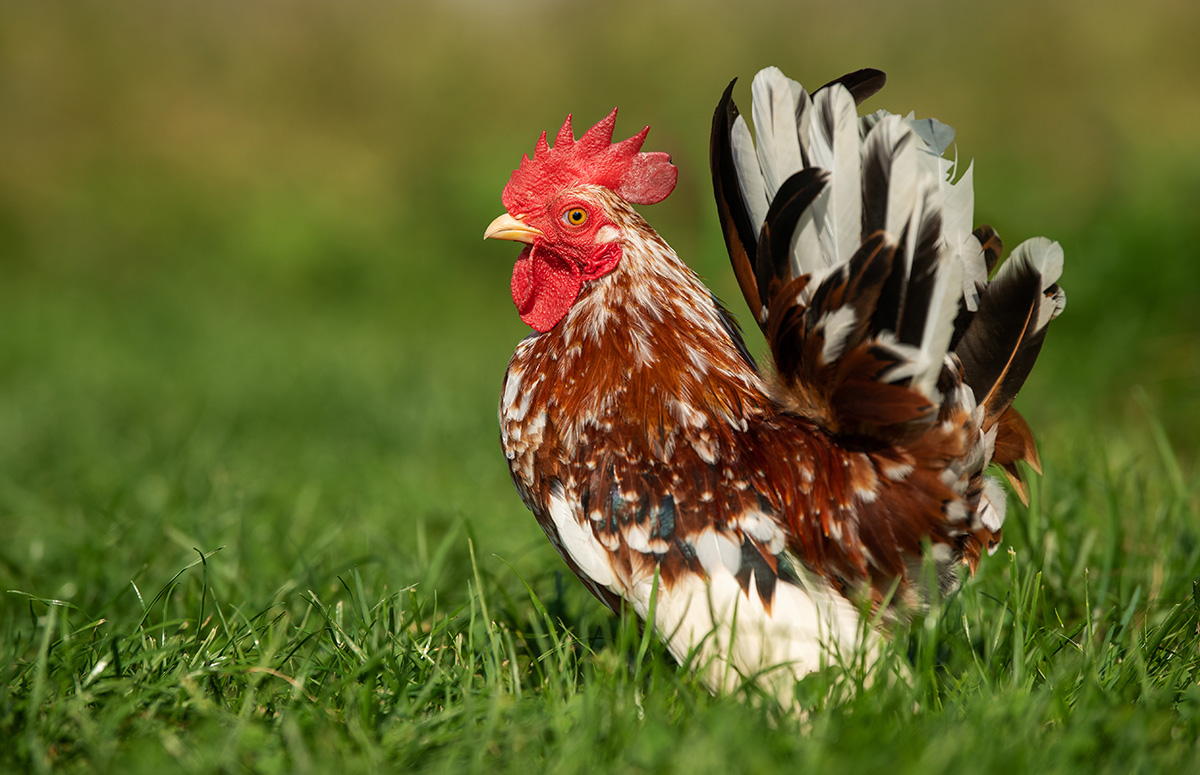
Like the Dutch Bantam, the Serama Bantam is also a true bantam type, meaning it does not have a large ancestor. It’s the smallest chicken breed in the world. The breed originates in Malaysia and can have any color variation. Their most distinctive characteristic is the V-shaped posture caused by the tail being carried in a 90 degrees corner.
They carry their wings very low, close to the ground, and, therefore, are unsuitable for wet climates or muddy environments. If weather circumstances are bad, keeping Serama chickens (temporarily) inside a shed or barn is best.
Seramas are decent egg layers, laying around 150 eggs per year. The egg color can be somewhere between brown and white.
If you’re planning on hatching Serama eggs, remember that this breed inherited a lethal gene from Japanese Bantams, causing 25% of chicks to die before hatching. They’re low in maintenance but not the easiest chicken to breed.
Things to keep in mind before buying a Serama:
- Not cold and wet hardy. They don’t like muddy, wet, and cold environments; even one cold night can cause death in a Serama chicken. Keep them inside a shed when the weather gets extreme.
- Carry a lethal gene, making the breeding process difficult. If you’re not planning on breeding with Serama chickens, this is not an issue.
4. Belgian D’Uccle
| Weight hen | Weight rooster |
| 23 oz (650 gr) | 28 oz (800 gr) |
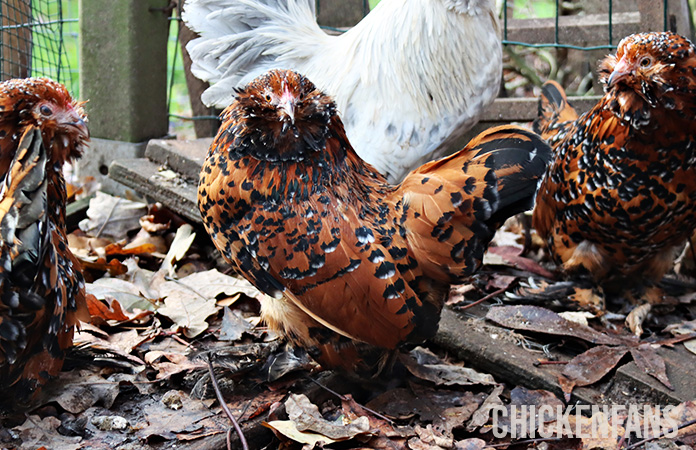
Another true Bantam breed is the Belgian Bearded D’Uccle or ‘Ukkelse Baardkriel’, which originates in the Belgian town of Uccle, near Brussels.
This breed is amiable and docile and is easily tamed or learned to do tricks. Children are especially very fond of the Belgian d’Uccle. They can easily be kept in a small run; check out the space requirements for bantams in our ‘Coop Size Calculator‘.
Their most beautiful and popular color is undoubted ‘Millefleur’, meaning ‘A Thousand Flowers’. But there are many more colors available.
They have an almost vertical tail and a prominent chest. The breed is most common in Belgium and its neighboring countries; France, Netherlands, Germany, and the UK.
There are breeders in the US, but unfortunately, most have lower-quality birds. However, this is less important if you’re not planning to enter pageants.
It’s essential to keep in mind that Belgian d’Uccle quickly becomes broody. This makes them excellent mothers, but it can be annoying if you’re not planning on hatching eggs.
The hens are ok layers, not the best, but they still lay up to 100 eggs annually.
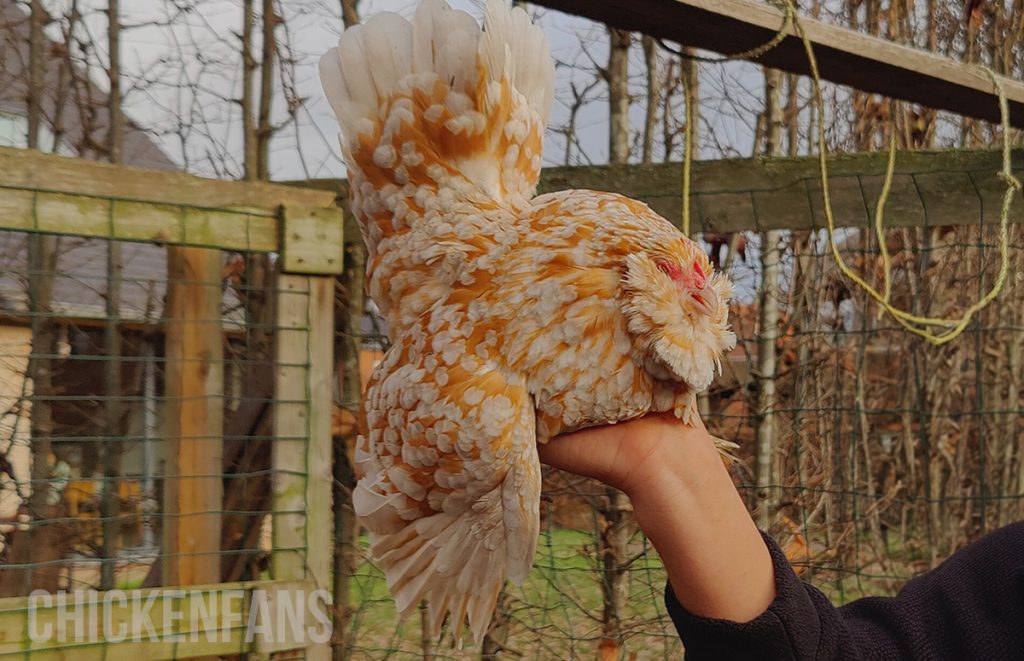
This breed is not cold nor heat hardy. This is not the breed for you if you live in a climate with extreme weather conditions. Like most small chicken breeds, Bearded d’Uccles do not like muddy or wet weather.
Things to keep in mind before buying a Belgian d’Uccle:
- Easily broody. Remember that broody chickens temporarily stop egg production and even forget to eat.
- Not cold hardy, nor heat hardy. Keep this breed inside a shed or barn when the weather is terrible.
- Lower quality birds in the US, but if you’re not planning to enter poultry pageants, this is not a problem.
5. Cochin (Pekin) Bantam
| Weight hen | Weight rooster |
| 28 oz (800 gr) | 32 oz (900 gr) |
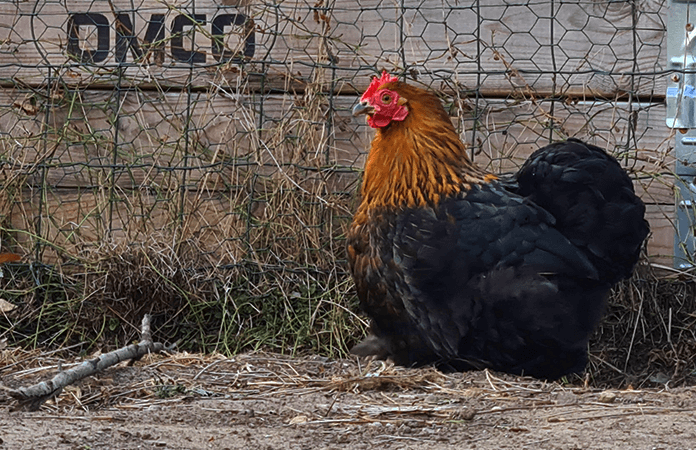
Cochin Bantams, also known as Pekin Bantams, are very popular with chicken keepers with families because of their fluffy look.
They’re easy to handle and low in maintenance, which makes them an excellent beginner-friendly breed. However, their body type makes Cochins prone to obesity, which can cause many health problems.
It’s a true Bantam breed, meaning it has no large fowl; although the Cochin is a very well-known large chicken breed, it has nothing to do with the Cochin Bantam. They’re two different breeds.
Cochin Bantams are ok egg layers, laying up to 150 small brown eggs annually. Hens often go broody, which is something to keep in mind if you’re not planning on hatching eggs.
They are cold and heat-hardy and can be kept in any climate. But remember, any chicken needs extra care during extreme weather conditions. Because Cochin Bantams have feathered feet and are small in size, keeping them in a run that’s not muddy or wet to prevent foot and fungi problems is essential.
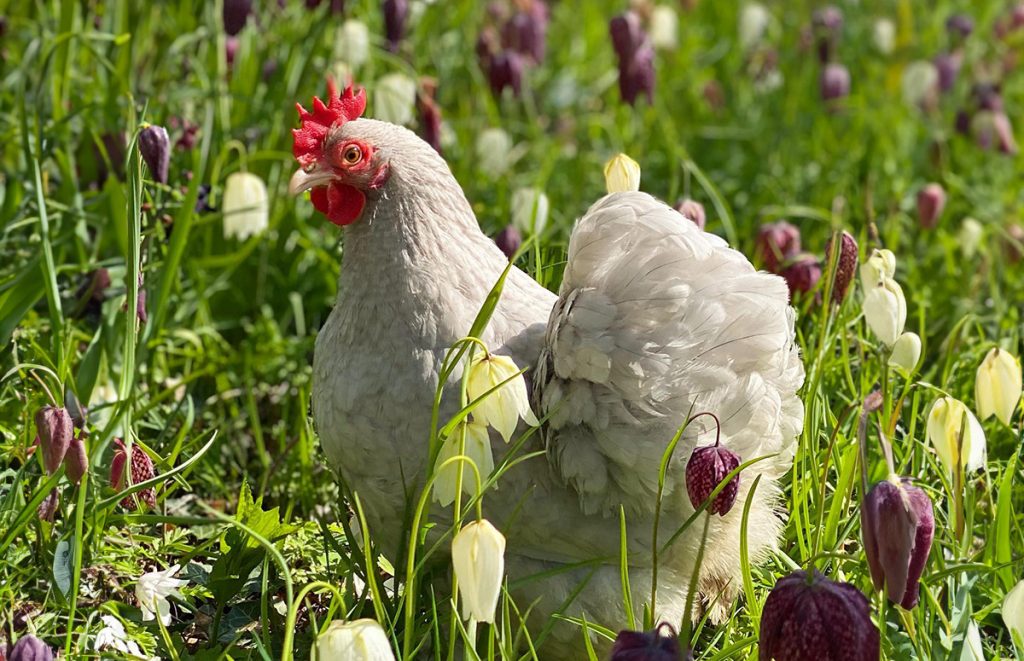
There are vast color and pattern varieties to be found in Cochin Bantams; this variation is what makes them popular. A fairly new feather type was introduced for the Cochin Bantam and is conquering the world: the Frizzle Cochin Bantam!
Frizzle Cochin Bantam
You should consider a Frizzle bird if a ‘normal’ Cochin Bantam isn’t cute or fluffy enough. These chickens have a dominant gene that makes the feathers curl upward and creates a ‘just out of bed’-look. Although the Frizzle Chicken is recognized as a separate breed in some countries, breeders are adding the gene to existing species to create a fluffy look.
The Frizzle Cochin has every good quality of a Cochin Bantam, plus the cute curly feathers. If you’re looking for a special-looking bird with show qualities but still a decent egg layer and a great pet, the Frizzle Cochin is the right breed.
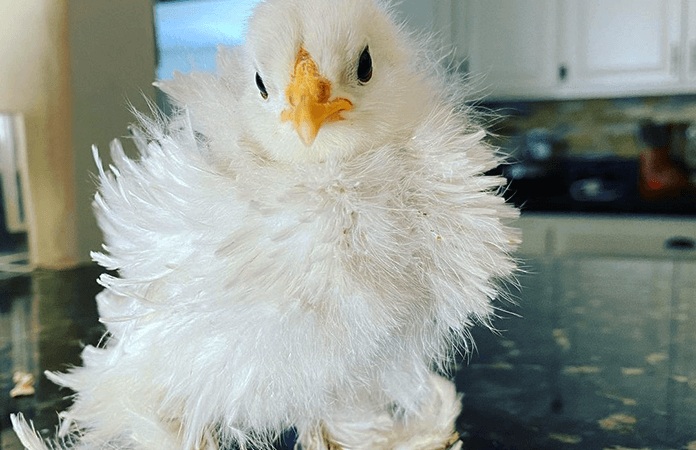
There is one downside to Frizzle chickens: The gene that makes the feathers curl upwards does not breed true and curly feathers aren’t shown on baby chicks. This means that approximately one-fourth of Frizzle chickens will have normal feathers, and you won’t know until they’re a little older.
Frizzle chickens are, due to their unique plumage, not flighty, and the feathers are not water resistant, so they are less fond of wet environments.
Things to keep in mind before buying a Cochin Bantam:
- Prone to obesity. Don’t feed Cochin Bantams too many treats; provide only the feed they need.
- Feathered feet don’t like wet environments. Chickens with heavily feathered feet must be checked regularly to prevent problems like fungi and bumblefoot.
- Frizzle chickens are not water resistant, and their unique feather type does not breed true.
6. Sebright
| Weight hen | Weight rooster |
| 20 oz (570 gr) | 22 oz (620 gr) |
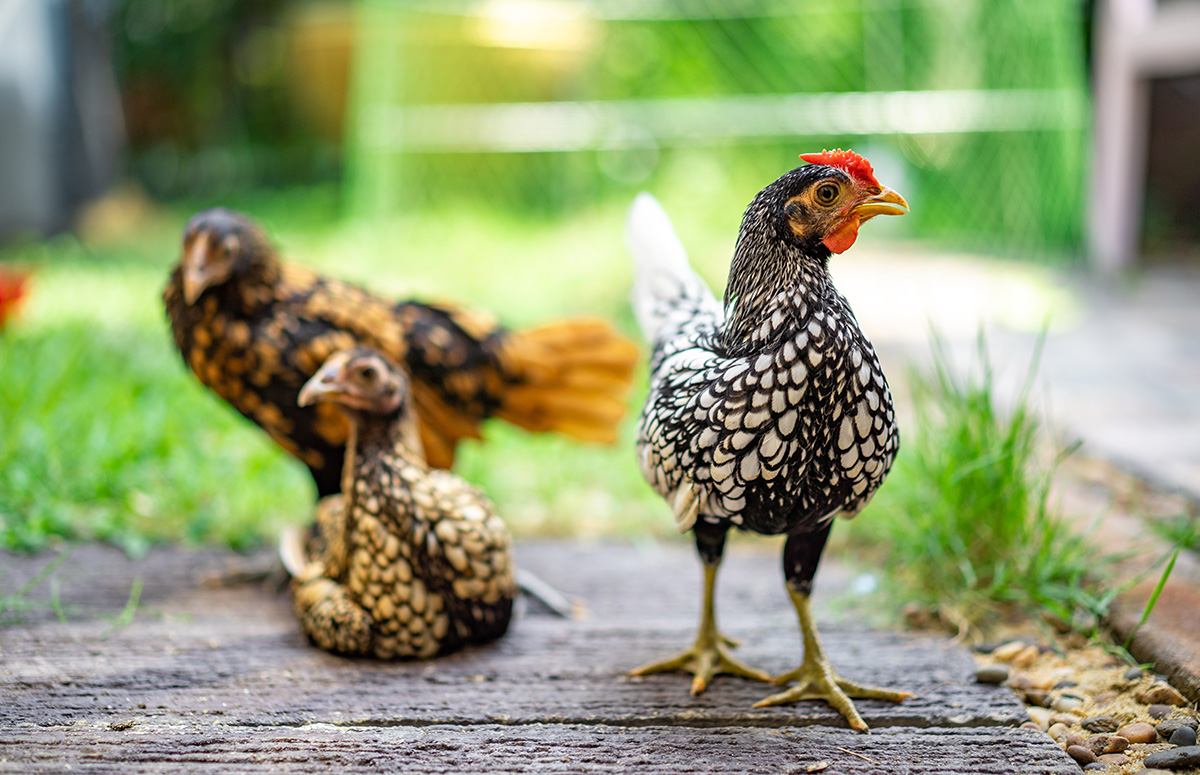
Another true Bantam breed is the Sebright chicken. It does not have a large chicken breed where it originated from and is one of the oldest recorded British Bantam breeds.
Sebrights are small chickens with laced feathering, a proportionally broad chest, and downward-pointing wings that almost touch the ground. Males and females share the same unique feathering due to a relatively uncommon condition called hen feathering.
Sebrights are one of the most popular Bantam breeds in the world. They’re cold and heat-hardy, seldom broody, and very friendly.
Like many bantam breeds with large wings, they can be somewhat flighty, so it’s best to keep them in a covered run. Sebrights make great pet chickens; they’re easily tamed and very sociable.
One downside to Sebright chickens; they are not the best egg layers. They lay between 60 – 100 tiny eggs annually, only one or two per week.
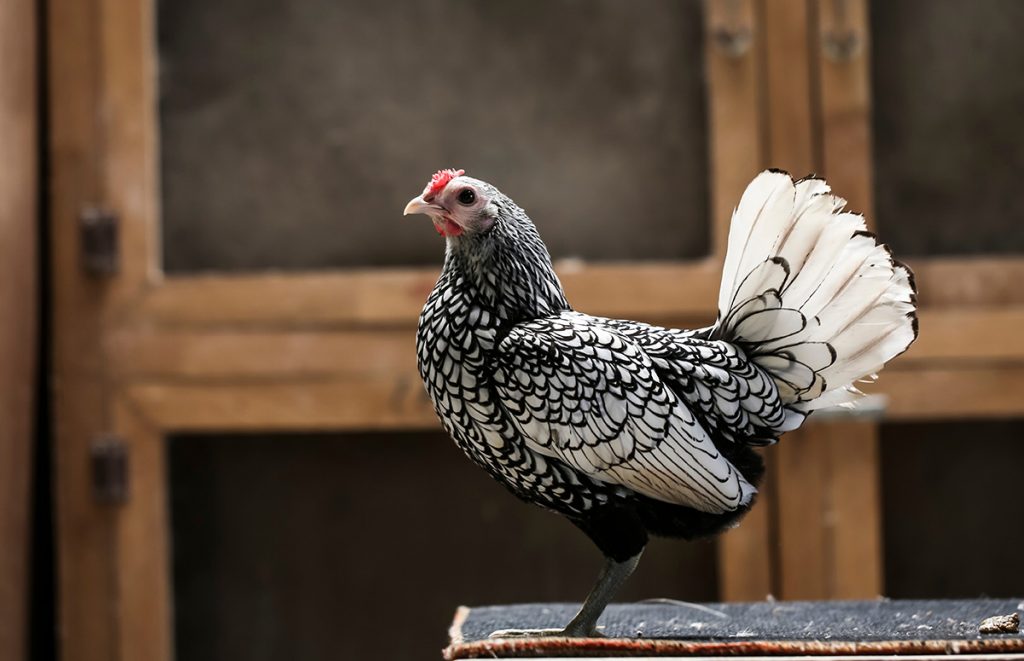
Most poultry enthusiasts keep Sebright chickens to enjoy their unique looks, participate in exhibitions, or keep them as pet chickens.
Adult Sebright chickens are pretty easy to raise, but you’ll need to do your homework when dealing with chicks or planning to breed with these birds. Chicks can have high mortality rates, and due to their genetics, males can occasionally be born infertile, which difficult the breeding process.
Things to consider before buying a Sebright chicken:
- Males and females have the same feathering. If you’re not planning on keeping a rooster, find a reputable breeder to inform you.
- Flighty birds. Cover the run; they’re fine in confinement but should be protected from predators for their safety.
- Hard to raise and breed. Keeping adult Sebright chickens is not that hard, but the mortality rate in chicks can be high, and breeding with Sebrights is challenging.
7. Modern Game Bantam
| Weight hen | Weight rooster |
| 20 oz (570 gr) | 22 oz (620 gr) |
This might be the stranger in our midst, but we’ll tell you why the Modern Game Bantam deserves a spot on this list. They may not be the cuddliest or fluffiest chickens, especially compared to the Silkie or Frizzled Cochin Bantam, but Modern Game Bantams make extraordinary pet chickens!
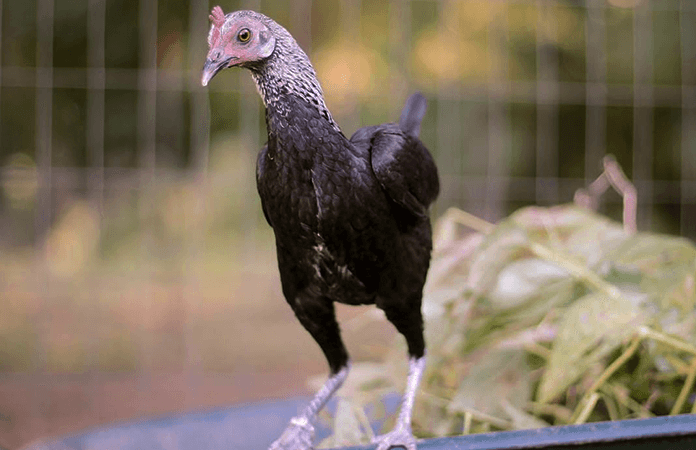
Modern Game Bantams are sociable, friendly, and curious chickens that love the company of humans. They’re easy to tame and great companions for children. On top of that, they are fairly good egg-layers, despite being game birds. Modern Game Bantams lay up to 100 eggs per year. They mature slower than other breeds and start laying at approximately 24 weeks.
This small breed does not need much care other than water, food, and shelter, making them a great ‘starter chicken’. They come in a wide range of colors so everyone can enjoy their preferred variety.
Modern Game Bantams have very long legs and are pretty skinny. This makes them very fast runners; good luck catching them when they’ve escaped!
Things to keep in mind before buying a Modern Game Bantam:
- Mature at a later age. They start laying at 24 weeks instead of 19-20 weeks for most breeds.
- Not fluffy. They are, after all, game chickens and look like game chickens with a muscular build. However, don’t let their look fool you; they are great pet chickens!
- Run fast. Because of their long legs, they can run very fast, which can be annoying when they’ve escaped the run.
8. Appenzeller Spitzhauben Bantam
| Weight hen | Weight rooster |
| 25 oz (700 gr) | 28 oz (800 gr) |
These chickens are the miniature version of the Appenzeller Spitzhauben chicken, a bird originating in Switzerland more than 300 years ago.
The bantam version was created in The Netherlands and arrived in two color varieties: Gold-black spangled and Silver-black spangled. The large fowl version is quite common, but the Bantam version can be harder to find.
Appenzeller Spitzhauben Bantams (that’s quite a mouthful) are a funny-looking breed with pointed feather crests and horned (V-shaped) combs.
Their unique look and friendly nature make them an excellent addition to your backyard flock. They’re decent egg layers and give you an excellent weekly amount of white eggs.
The Appenzeller Spitzhauben Bantam is an active breed that does not like confinement. They’re happiest when allowed to free-range; therefore, unlike most small chicken breeds, they are not best to be kept when you have limited space.
Things to consider before buying an Appenzeller Bantam:
- Active breed. Need lots of space, or let them free-range.
- Rare. Bantams are not always easy to find.
9. Belgian Barbu d’Anvers
| Weight hen | Weight rooster |
| 21 oz (600 gr) | 25 oz (700 gr) |
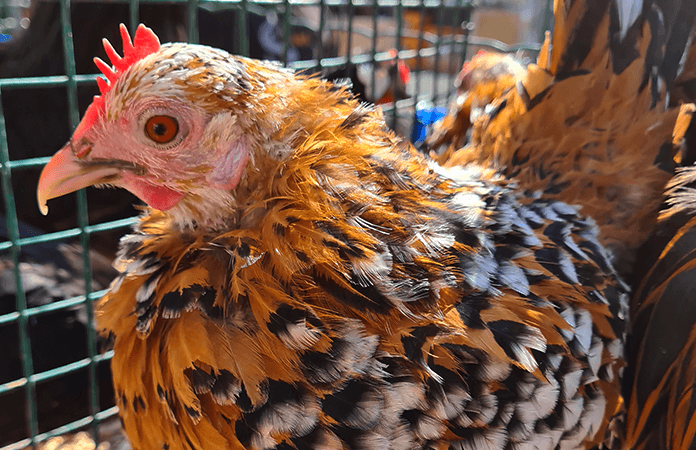
Another Belgian Bantam breed to discuss is the Belgian d’Anvers, originating in the Northern city of Antwerp and one of the oldest Bantam breeds in the world.
The Belgian Bearded d’Uccle, also in this list, was created by crossing the Belgian d’Anvers with the Booted Bantam, a Dutch Bantam breed. That makes them all somehow related and look like each other.
The Bearded d’Anvers is an ornamental bird that lays up to 100 eggs annually. They’re friendly and love interaction with humans.
These small chickens are curious and follow you around in the garden if you let them free-range. They’re also quite active, and the roosters can be noisy.
This breed is quite hardy but does not like wet environments. Keep them in a covered run, or in a dry area.
Things to consider before buying a Belgian Bearded d’Anvers:
- Roosters can be loud and active, which can be annoying if you live in a suburban environment.
- Don’t like muddy and wet environments.
10. Booted Bantam
| Weight hen | Weight rooster |
| 23 oz (650 gr) | 30 oz (850 gr) |
The Booted Bantam, or ‘Dutch Sabelpootkriel’, is a Dutch true bantam breed. Its most remarkable characteristic is the abundance of feathering on the feet and shanks, giving it its ‘booted’ appearance.
This breed is mainly kept as a show bird, but they are very good egg layers, laying up to 120 eggs per year. All eggs are white-colored and very tiny. The egg size makes them not really wanted as an egg-laying breed, but obviously, you can eat the eggs.
These chickens are fairly cold-hardy but are best kept in a covered run, so their feet feathering doesn’t get wet. Like most breeds with feathered feet, they don’t like muddy and wet environments.
Things to keep in mind before buying a Booted Bantam:
- Tiny eggs. They lay a decent amount of eggs, around 120 yearly, but all eggs are very small.
- Best kept in a covered run, so their feathered feet don’t get wet.
Summary
There are hundreds of chicken breeds, small and big! If you want to get to know them all, rare and common, go to our ‘All Chicken Breeds & Types Worldwide: List of 500+ Breeds‘.
Credits Featured Image: @persnicketpoultry (IG)






















